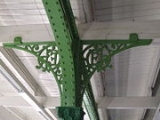
Fairlop Loop
Encyclopedia
The Fairlop Loop was a 6.5-mile (10 km) branch line of the Great Eastern Railway
(GER). It opened to freight on 20 April 1903 and to passengers on 1 May 1903. It connected Woodford on the Ongar branch to Ilford
on the Main Line
, along with an eastward freight connection for freight, excursions and stock transfers to Seven Kings
. Today it is the greater part of the Hainault Loop on London Underground
's Central line
, the remainder consisting of a 4.1-mile (6.6 km) deep-level underground line (opened 14 December 1947) connecting Newbury Park
on the loop with Leytonstone
on the Ongar (now Epping
) branch.
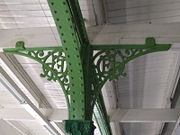 The GER built the line to foster suburban growth in Edwardian Ilford and Chigwell; the results were mixed. Hainault station had so few passengers that it closed between 1908 and 1930. The loop passed to the London and North Eastern Railway
The GER built the line to foster suburban growth in Edwardian Ilford and Chigwell; the results were mixed. Hainault station had so few passengers that it closed between 1908 and 1930. The loop passed to the London and North Eastern Railway
(LNER) in 1923 after the grouping
of railways into The Big Four. The LNER added a station at Roding Valley in 1936 to serve a housing development. Most of the route transferred to the Central line of the London Transport Executive
(LTE) during 1947 and 1948 as part of the war-delayed New Works Programme
. The transfer brought fourth-rail electrification to replace steam and construction of a deep-level line connecting Leytonstone
on the Ongar branch with Newbury Park
on the loop, together with severing connections between Newbury Park and Ilford and Seven Kings.
First to go was the westward curve between Newbury Park Junction and Ilford Carriage Sidings Junction, on 30 November 1947. The other connection to Seven Kings West Junction was freight-only but endured until 19 March 1956. The whole triangular junction disappeared under expansion of Ilford carriage sheds in 1959. Freight trains operated by British Rail
continued using the remaining loop via Woodford as far as Newbury Park until 4 October 1965. A short turn-back siding was provided on the former track-bed south of Newbury Park, which once freight trains were withdrawn was used by engineers' trains until 1992.
. The apex of the triangle was Newbury Park Junction (just south of Vicarage Lane), the western side was Ilford Carriage Sidings Junction, and the eastern side was Seven Kings West Junction.
The topography challenged engineers . The line was on the surface but 260 yards or 238m of tunnel needed to be bored immediately to the north of . The line between Roding Valley and Chigwell was on an embankment, and a three-arch viaduct was built over the River Roding
. Further east, the embankment was bisected by the London end of the M11 motorway
in 1977), a concrete bridge carrying the Central line over the road. Chigwell and Grange Hill were built in cuttings, Hainault and Fairlop were built on embankments, and most of the route south of Barkingside including Newbury Park was also in a cutting. Only the platforms at Roding Valley and Barkingside (eastbound only) are accessible from street level. Works for accessibility to each of the platforms at Roding Valley were completed in 2009; hitherto there were a couple of steps to street level.
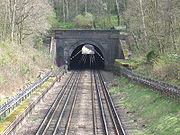 Goods yards were built at Grange Hill (closed 1965), Hainault (closed 1908), Fairlop (closed 1958), Barkingside and Newbury Park (both closed 1965). One of the former sidings at Newbury Park is now used as the eastbound through track, with the former eastbound track normally used only for reversing, though it retains the connection facing Barkingside. The sidings at Grange Hill now form part of the north-facing access from Hainault Depot. They extend as far as parallel to the station platforms, and there are also sidings at the southern end of the depot, next to the platforms at Hainault station. East of Chigwell, a short siding served Chigwell Nursery in GER days, but this was taken out of service at an unknown time, probably before Grouping into the LNER (the nursery was sold in 1922).
Goods yards were built at Grange Hill (closed 1965), Hainault (closed 1908), Fairlop (closed 1958), Barkingside and Newbury Park (both closed 1965). One of the former sidings at Newbury Park is now used as the eastbound through track, with the former eastbound track normally used only for reversing, though it retains the connection facing Barkingside. The sidings at Grange Hill now form part of the north-facing access from Hainault Depot. They extend as far as parallel to the station platforms, and there are also sidings at the southern end of the depot, next to the platforms at Hainault station. East of Chigwell, a short siding served Chigwell Nursery in GER days, but this was taken out of service at an unknown time, probably before Grouping into the LNER (the nursery was sold in 1922).
east of Leytonstone at Leytonstone Junction, with the tracks passing to either side of the latter and immediately diving underground. The route heads mostly beneath the alignment of the A12 Eastern Avenue as far as Gants Hill
. East of here the alignment turns southeast along Perth Road, then turns east to pass beneath Ley Street to hit the alignment of Wards Road, before curving northwards beneath Glebelands Avenue to reach the surface just south of Newbury Park, with the tracks passing to either side of the track bed of the former line to Ilford, this explains the relatively long tunnel between Gants Hill and Newbury Park stations. The tunnels were essentially completed when the Second World War broke out in 1939, and between 1942 and the end of hostilities, they were put to use as an underground munitions factory
(complete with its own 18 in (457 mm) railway) by the Plessey
company, who were based in Ilford for many years. Redbridge
station holds the record for the shallowest "deep-level" station on the London Underground network, being only 26 feet (7.9 m) below street level, necessitating just a short of flight of stairs for entry. Gants Hill and Wanstead, due to their greater depth, are provided with escalators, though passengers at the former need additional ramps or stairs to reach the surface.
, opened 22 August 1856 by the Eastern Counties Railway
(ECR), closed briefly before re-opening 14 December 1947 as part of the Central line
.
Fairlop Loop diverges from the Ongar (now Epping
) Branch at Woodford Junction, opened 3 February 1936 as Roding Valley Halt by the LNER, closed 29 November 1947 before re-opening 21 November 1948 as part of the Central line., opened 1 May 1903 by the GER, closed 29 November 1947 before re-opening 21 November 1948., opened 1 May 1903 by the GER, closed 29 November 1947 before re-opening 21 November 1948., opened 1 May 1903 by the GER, closed 1 October 1908 until 3 March 1930. Closed 29 November 1947 before re-opening 31 May 1948., opened 1 May 1903 by the GER, closed 29 November 1947 before re-opening 31 May 1948., opened 1 May 1903 by the GER, closed 22 May 1916 until 30 June 1919. Closed 29 November 1947 before re-opening 31 May 1948., opened 1 May 1903 by the GER, closed 29 November 1947 before re-opening 14 December 1947 as part of the Central line.
Remainder of Fairlop loop connects with Central line tube from Leytonstone (nowadays both parts referred to as the "Hainault Loop"), opened by LTE 14 December 1947., opened by LTE 14 December 1947., opened by LTE 14 December 1947.
re-joins the Ongar (Epping) Branch at Leytonstone Junction, opened 22 August 1856 by the ECR, closed briefly before re-opening 5 May 1947 as part of the Central line.
award in 1951, and both it and Barkingside station are Grade II Listed buildings. Additionally, the interior of Gants Hill was heavily inspired by the Moscow Metro
. Externally, however, Gants Hill lacks a proper station building, being built directly underneath the busy A12 roundabout of the same name. Due to bomb damage to Grange Hill in 1944, and expansion of the A12 Eastern Avenue at Newbury Park in 1956, the original station buildings at these locations were demolished. They were almost identical to that at Chigwell. Newbury Park was meant to receive a replacement building but it was never built, and the only entrance is via the bus shelter. Hainault's original structure, prior to the rebuilding due to the addition of Hainault Depot, was very similar to that at Fairlop. Roding Valley alone had rather basic buildings upon opening, with an all-wooden shelter on the Woodford-bound side, though these were replaced by more substantial structures when transferred to the Central line. Notable architects included Oliver Hill for Newbury Park bus shelter, and W N Ashbee for the original six stations from Chigwell to Newbury Park (though the Listing authorities credit William Burgess for Barkingside, possibly erroneously). Renowned London Underground
architect Charles Holden
designed the three all-new underground stations which opened in 1947.
off Glebelands Avenue. South of there, there is a stretch of derelict land followed by a small area of allotment
gardens north of Wards Road, with more allotments to the south of there and north of Benton Road. South of Benton Road, an outbuilding of St. Aidan's School as well some new blocks of flats (Friars Close) occupy the alignment as far south as Vicarage Lane, whilst south of there are yet more flats (Piper Way) lying just to the north of Ilford Carriage Sheds, the expansion of which followed the initial severing of the Newbury Park Junction to Ilford Carriage Sidings Junction curve in November 1947. The route was abandoned fully when the connecting curve to Seven Kings West Junction was lifted in 1956. The site of this curve is now occupied by the depot's "New Shed", opened in 1959. Little evidence remains for the former junctions at the Main Line end.
Great Eastern Railway
The Great Eastern Railway was a pre-grouping British railway company, whose main line linked London Liverpool Street to Norwich and which had other lines through East Anglia...
(GER). It opened to freight on 20 April 1903 and to passengers on 1 May 1903. It connected Woodford on the Ongar branch to Ilford
Ilford
Ilford is a large cosmopolitan town in East London, England and the administrative headquarters of the London Borough of Redbridge. It is located northeast of Charing Cross and is one of the major metropolitan centres identified in the London Plan. It forms a significant commercial and retail...
on the Main Line
Great Eastern Main Line
The Great Eastern Main Line is a 212 Kilometre major railway line of the British railway system, which connects Liverpool Street in the City of London with destinations in east London and the East of England, including Chelmsford, Colchester, Ipswich, Norwich and several coastal resorts such as...
, along with an eastward freight connection for freight, excursions and stock transfers to Seven Kings
Seven Kings
Seven Kings is a district of Ilford in north-east London, England. It is part of the London Borough of Redbridge and forms part of the Ilford post town....
. Today it is the greater part of the Hainault Loop on London Underground
London Underground
The London Underground is a rapid transit system serving a large part of Greater London and some parts of Buckinghamshire, Hertfordshire and Essex in England...
's Central line
Central Line
The Central line is a London Underground line, coloured red on the tube map. It is a deep-level "tube" line, running east-west across London, and, at , has the greatest total length of track of any line on the Underground. Of the 49 stations served, 20 are below ground...
, the remainder consisting of a 4.1-mile (6.6 km) deep-level underground line (opened 14 December 1947) connecting Newbury Park
Newbury Park, London
Newbury Park is a district of Ilford in North-East Greater London, situated in the London Borough of Redbridge east of Gants Hill. The main road is the Eastern Avenue , which until the 1920s was a country lane called Hatch Lane. The main landmark in this town is the Tube station whose post-war bus...
on the loop with Leytonstone
Leytonstone
Leytonstone is an area of east London and part of the London Borough of Waltham Forest. It is a high density suburban area, located seven miles north east of Charing Cross in the ceremonial county of Greater London and the historic county of Essex...
on the Ongar (now Epping
Epping
Epping is a small market town and civil parish in the Epping Forest district of the County of Essex, England. It is located north-east of Loughton, south of Harlow and north-west of Brentwood....
) branch.
History

London and North Eastern Railway
The London and North Eastern Railway was the second-largest of the "Big Four" railway companies created by the Railways Act 1921 in Britain...
(LNER) in 1923 after the grouping
Railways Act 1921
The Railways Act 1921, also known as the Grouping Act, was an enactment by the British government of David Lloyd George intended to stem the losses being made by many of the country's 120 railway companies, move the railways away from internal competition, and to retain some of the benefits which...
of railways into The Big Four. The LNER added a station at Roding Valley in 1936 to serve a housing development. Most of the route transferred to the Central line of the London Transport Executive
London Transport Executive
The London Transport Executive was the organisation responsible for public transport in the Greater London area, UK, between 1948-1962. In common with all London transport authorities from 1933 to 2000, the public name and operational brand of the organisation was London Transport.-Creation:On 1...
(LTE) during 1947 and 1948 as part of the war-delayed New Works Programme
New Works Programme
The "New Works Programme, 1935 - 1940" was the major investment programme delivered by the London Passenger Transport Board , commonly known as London Transport, which had been created in 1933 to coordinate underground train, tram, trolleybus and bus services in the capital and the surrounding areas...
. The transfer brought fourth-rail electrification to replace steam and construction of a deep-level line connecting Leytonstone
Leytonstone
Leytonstone is an area of east London and part of the London Borough of Waltham Forest. It is a high density suburban area, located seven miles north east of Charing Cross in the ceremonial county of Greater London and the historic county of Essex...
on the Ongar branch with Newbury Park
Newbury Park, London
Newbury Park is a district of Ilford in North-East Greater London, situated in the London Borough of Redbridge east of Gants Hill. The main road is the Eastern Avenue , which until the 1920s was a country lane called Hatch Lane. The main landmark in this town is the Tube station whose post-war bus...
on the loop, together with severing connections between Newbury Park and Ilford and Seven Kings.
First to go was the westward curve between Newbury Park Junction and Ilford Carriage Sidings Junction, on 30 November 1947. The other connection to Seven Kings West Junction was freight-only but endured until 19 March 1956. The whole triangular junction disappeared under expansion of Ilford carriage sheds in 1959. Freight trains operated by British Rail
British Rail
British Railways , which from 1965 traded as British Rail, was the operator of most of the rail transport in Great Britain between 1948 and 1997. It was formed from the nationalisation of the "Big Four" British railway companies and lasted until the gradual privatisation of British Rail, in stages...
continued using the remaining loop via Woodford as far as Newbury Park until 4 October 1965. A short turn-back siding was provided on the former track-bed south of Newbury Park, which once freight trains were withdrawn was used by engineers' trains until 1992.
Woodford to Ilford
The Loop was double tracked and all six original stations were provided with two 600 ft (183 m) platforms, though the 1936 station at Roding Valley was built with 500 ft (152 m) platforms. Hainault station re-opened in 1948 with a third platform It is today used by terminating Central line trains. A simple fork at the northern end at Woodford Junction let trains leave or join the Ongar branch. A triangular junction at the southern end gave access to the main line, the site now occupied by Ilford carriage sheds and a maintenance depot run by BombardierBombardier Transportation
Bombardier Transportation is the rail equipment division of the Canadian firm, Bombardier Inc. Bombardier Transportation is one of the world's largest companies in the rail-equipment manufacturing and servicing industry. Its headquarters are in Berlin, Germany....
. The apex of the triangle was Newbury Park Junction (just south of Vicarage Lane), the western side was Ilford Carriage Sidings Junction, and the eastern side was Seven Kings West Junction.
The topography challenged engineers . The line was on the surface but 260 yards or 238m of tunnel needed to be bored immediately to the north of . The line between Roding Valley and Chigwell was on an embankment, and a three-arch viaduct was built over the River Roding
River Roding
The River Roding is a river in England that rises near Dunmow, flows through Essex and forms Barking Creek as it reaches the River Thames in London....
. Further east, the embankment was bisected by the London end of the M11 motorway
M11 motorway
The M11 motorway in England is a major road running approximately north from the North Circular Road in South Woodford in north-east London to the A14, north-west of Cambridge.-Route:...
in 1977), a concrete bridge carrying the Central line over the road. Chigwell and Grange Hill were built in cuttings, Hainault and Fairlop were built on embankments, and most of the route south of Barkingside including Newbury Park was also in a cutting. Only the platforms at Roding Valley and Barkingside (eastbound only) are accessible from street level. Works for accessibility to each of the platforms at Roding Valley were completed in 2009; hitherto there were a couple of steps to street level.

Newbury Park to Leytonstone
The tube line built between Leytonstone and Newbury Park is of standard twin bore construction, with the three intermediate stations all having central platforms. The route diverges from the Ongar branchCentral Line
The Central line is a London Underground line, coloured red on the tube map. It is a deep-level "tube" line, running east-west across London, and, at , has the greatest total length of track of any line on the Underground. Of the 49 stations served, 20 are below ground...
east of Leytonstone at Leytonstone Junction, with the tracks passing to either side of the latter and immediately diving underground. The route heads mostly beneath the alignment of the A12 Eastern Avenue as far as Gants Hill
Gants Hill
Gants Hill is a district of Ilford in the London Borough of Redbridge in northeast London, England. It is a suburban development situated north east of Charing Cross....
. East of here the alignment turns southeast along Perth Road, then turns east to pass beneath Ley Street to hit the alignment of Wards Road, before curving northwards beneath Glebelands Avenue to reach the surface just south of Newbury Park, with the tracks passing to either side of the track bed of the former line to Ilford, this explains the relatively long tunnel between Gants Hill and Newbury Park stations. The tunnels were essentially completed when the Second World War broke out in 1939, and between 1942 and the end of hostilities, they were put to use as an underground munitions factory
Factory
A factory or manufacturing plant is an industrial building where laborers manufacture goods or supervise machines processing one product into another. Most modern factories have large warehouses or warehouse-like facilities that contain heavy equipment used for assembly line production...
(complete with its own 18 in (457 mm) railway) by the Plessey
Plessey
The Plessey Company plc was a British-based international electronics, defence and telecommunications company. It originated in 1917, growing and diversifying into electronics. It expanded after the second world war by acquisition of companies and formed overseas companies...
company, who were based in Ilford for many years. Redbridge
Redbridge tube station
Redbridge tube station is a London Underground station in Redbridge, on the Hainault Loop of the Central line, in Zone 4. It is on the Eastern Avenue....
station holds the record for the shallowest "deep-level" station on the London Underground network, being only 26 feet (7.9 m) below street level, necessitating just a short of flight of stairs for entry. Gants Hill and Wanstead, due to their greater depth, are provided with escalators, though passengers at the former need additional ramps or stairs to reach the surface.
Stations served
In order from northwest to southeast, opened 22 August 1856 by the Eastern Counties Railway
Eastern Counties Railway
The Eastern Counties Railway was an early English railway company incorporated in 1836. It was intended to link London with Ipswich via Colchester, and then on to Norwich and Yarmouth. Construction began in late March 1837 on the first nine miles, at the London end of the line.Construction was...
(ECR), closed briefly before re-opening 14 December 1947 as part of the Central line
Central Line
The Central line is a London Underground line, coloured red on the tube map. It is a deep-level "tube" line, running east-west across London, and, at , has the greatest total length of track of any line on the Underground. Of the 49 stations served, 20 are below ground...
.
Fairlop Loop diverges from the Ongar (now Epping
Epping
Epping is a small market town and civil parish in the Epping Forest district of the County of Essex, England. It is located north-east of Loughton, south of Harlow and north-west of Brentwood....
) Branch at Woodford Junction, opened 3 February 1936 as Roding Valley Halt by the LNER, closed 29 November 1947 before re-opening 21 November 1948 as part of the Central line., opened 1 May 1903 by the GER, closed 29 November 1947 before re-opening 21 November 1948., opened 1 May 1903 by the GER, closed 29 November 1947 before re-opening 21 November 1948., opened 1 May 1903 by the GER, closed 1 October 1908 until 3 March 1930. Closed 29 November 1947 before re-opening 31 May 1948., opened 1 May 1903 by the GER, closed 29 November 1947 before re-opening 31 May 1948., opened 1 May 1903 by the GER, closed 22 May 1916 until 30 June 1919. Closed 29 November 1947 before re-opening 31 May 1948., opened 1 May 1903 by the GER, closed 29 November 1947 before re-opening 14 December 1947 as part of the Central line.
- Former connection: Fairlop Loop joins Great Eastern Main Line via westward curve between Newbury Park Junction and Ilford Carriage Sidings Junction
- , opened 20 June 1839 by the Eastern Counties Railway. Operated by National Express East Anglia as of late 2007. Connection closed 30 November 1947.
- Former connection (freight-only): Fairlop Loop joins Great Eastern Main Line via eastward curve between Newbury Park Junction and Seven Kings West Junction
- , opened 1 March 1899 by the GER. Operated by National Express East Anglia as of late 2007. Connection closed 19 March 1956. (NB. station never served by scheduled Fairlop Loop passenger trains)
Remainder of Fairlop loop connects with Central line tube from Leytonstone (nowadays both parts referred to as the "Hainault Loop"), opened by LTE 14 December 1947., opened by LTE 14 December 1947., opened by LTE 14 December 1947.
re-joins the Ongar (Epping) Branch at Leytonstone Junction, opened 22 August 1856 by the ECR, closed briefly before re-opening 5 May 1947 as part of the Central line.
Station architecture
Most of the surface stations of the former Fairlop loop as well as the newer underground stations on the Hainault loop are notable for their architecture, dating from Edwardian to the London Transport style of the 1930s/1940s. The bus station shelter at Newbury Park won a Festival of BritainFestival of Britain
The Festival of Britain was a national exhibition in Britain in the summer of 1951. It was organised by the government to give Britons a feeling of recovery in the aftermath of war and to promote good quality design in the rebuilding of British towns and cities. The Festival's centrepiece was in...
award in 1951, and both it and Barkingside station are Grade II Listed buildings. Additionally, the interior of Gants Hill was heavily inspired by the Moscow Metro
Moscow Metro
The Moscow Metro is a rapid transit system serving Moscow and the neighbouring town of Krasnogorsk. Opened in 1935 with one line and 13 stations, it was the first underground railway system in the Soviet Union. As of 2011, the Moscow Metro has 182 stations and its route length is . The system is...
. Externally, however, Gants Hill lacks a proper station building, being built directly underneath the busy A12 roundabout of the same name. Due to bomb damage to Grange Hill in 1944, and expansion of the A12 Eastern Avenue at Newbury Park in 1956, the original station buildings at these locations were demolished. They were almost identical to that at Chigwell. Newbury Park was meant to receive a replacement building but it was never built, and the only entrance is via the bus shelter. Hainault's original structure, prior to the rebuilding due to the addition of Hainault Depot, was very similar to that at Fairlop. Roding Valley alone had rather basic buildings upon opening, with an all-wooden shelter on the Woodford-bound side, though these were replaced by more substantial structures when transferred to the Central line. Notable architects included Oliver Hill for Newbury Park bus shelter, and W N Ashbee for the original six stations from Chigwell to Newbury Park (though the Listing authorities credit William Burgess for Barkingside, possibly erroneously). Renowned London Underground
London Underground
The London Underground is a rapid transit system serving a large part of Greater London and some parts of Buckinghamshire, Hertfordshire and Essex in England...
architect Charles Holden
Charles Holden
Charles Henry Holden, Litt. D., FRIBA, MRTPI, RDI was a Bolton-born English architect best known for designing many London Underground stations during the 1920s and 1930s, for Bristol Central Library, the Underground Electric Railways Company of London's headquarters at 55 Broadway and for the...
designed the three all-new underground stations which opened in 1947.
 |  |  |
 | 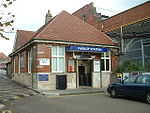 | 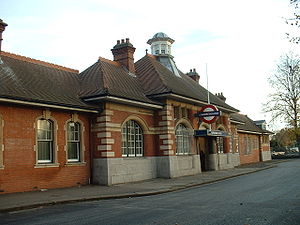 |
 |  | |
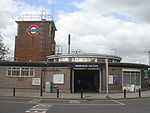 | 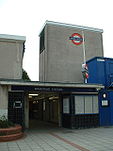 |
Since 1947 (Central line)
Typical off-peak service pattern (as of 2007):- Through trains central LondonLondonLondon is the capital city of :England and the :United Kingdom, the largest metropolitan area in the United Kingdom, and the largest urban zone in the European Union by most measures. Located on the River Thames, London has been a major settlement for two millennia, its history going back to its...
- - via : every 6-10 mins until c. 01:00 (1 am). - as above but additionally Hainault - : every 20 mins until 00:00 (midnight).
- additional trains from to Newbury Park only, every 20 mins.
Before 1947 (GER/LNER)
Typical service pattern by 1933 (LNER):- Service frequency half-hourly during the day, circular service typically London Liverpool Street - Stratford - Ilford - Woodford - Stratford - London Liverpool Street.
Since 1947 (Central line)
- Standard tube stock 1947-1963 (final withdrawal)
- 1959 tube stock 1960-1964
- 1962 tube stock 1962-1995 (final withdrawal)
- 1992 tube stock 1993–present
- Hainault - Woodford shuttle service saw a variety of different stock from the early 1960s in conjunction with experimental Automatic Train OperationAutomatic train operationAutomatic train operation ensures partial or complete automatic train piloting and driverless functions.Most systems elect to maintain a driver to mitigate risks associated with failures or emergencies....
(ATO), such as 1960 tube stockLondon Underground 1960 StockThe London Underground 1960 Stock was a small, prototype class of electric multiple unit designed for the London Underground Central Line. Twelve motor cars were supplied by Cravens, and pairs were made up to four cars by the addition of two converted standard stock trailers...
and trials of both 1967 tube stockLondon Underground 1967 StockThe 1967 Stock was a fleet of deep-level tube stock which operated on the Victoria line between 1 September 1968 and 30 June 2011, and was the original rolling stock provided from the line's opening...
and modified 1973 tube stock, prior to introduction of the 1992 trains.
Before 1947 (GER/LNER)
- Steam locomotives included Holden 2-4-2T tank engines and Hill 0-6-2T tank engines built by the GER, while carriages were usually of the short wheelbaseWheelbaseIn both road and rail vehicles, the wheelbase is the distance between the centers of the front and rear wheels.- Road :In automobiles, the wheelbase is the horizontal distance between the center of the front wheel and the center of the rear wheel...
type and numbered up to 16 per train.
The disused connection today
The disused connection between Ilford/Seven Kings and Newbury Park is relatively short, at approximately 0.8 miles (1.3 km) long, but it is still evident at ground level. This is despite the track being lifted many years ago. From south to north, there are three road bridges, Vicarage Lane, Benton Road and Wards Road apparently crossing over a missing alignment, though much of the route was in a cutting that has been filled in since the line closed. Also, south of Newbury Park, the inclines to/from the tunnel portals towards Gants Hill diverge away from what's left of the former route. Immediately to the south is an electrical substationElectrical substation
A substation is a part of an electrical generation, transmission, and distribution system. Substations transform voltage from high to low, or the reverse, or perform any of several other important functions...
off Glebelands Avenue. South of there, there is a stretch of derelict land followed by a small area of allotment
Allotment (gardening)
An allotment garden, often called simply an allotment, is a plot of land made available for individual, non-professional gardening. Such plots are formed by subdividing a piece of land into a few or up to several hundreds of land parcels that are assigned to individuals or families...
gardens north of Wards Road, with more allotments to the south of there and north of Benton Road. South of Benton Road, an outbuilding of St. Aidan's School as well some new blocks of flats (Friars Close) occupy the alignment as far south as Vicarage Lane, whilst south of there are yet more flats (Piper Way) lying just to the north of Ilford Carriage Sheds, the expansion of which followed the initial severing of the Newbury Park Junction to Ilford Carriage Sidings Junction curve in November 1947. The route was abandoned fully when the connecting curve to Seven Kings West Junction was lifted in 1956. The site of this curve is now occupied by the depot's "New Shed", opened in 1959. Little evidence remains for the former junctions at the Main Line end.
Ilford to Newbury Park: modern alternatives
The recent construction of residential blocks, as well as the long-standing and ongoing use of the alignment for allotment gardens, means that there can be no re-instatement of the rail-link between Ilford and Newbury Park. The Central line serves both Stratford and Liverpool Street, just as the old Fairlop Loop line services did, and to travel by rail between Newbury Park and Ilford requires a relatively simple change of trains at Stratford. However, more direct routes involve local bus routes 296 and 396, serving both stations directly, and a third route, the 169, serving Ley Street and Horns Road a few hundred yards to the west of Newbury Park. The 296 and 396 head west along the Eastern Avenue as far as Gants Hill, before turning south, whilst the 169 is actually a less circuitous route.See also
- London Underground Central lineCentral LineThe Central line is a London Underground line, coloured red on the tube map. It is a deep-level "tube" line, running east-west across London, and, at , has the greatest total length of track of any line on the Underground. Of the 49 stations served, 20 are below ground...
- Epping Ongar RailwayEpping Ongar RailwayThe Epping Ongar Railway operates on a preserved railway along the final section of the old Great Eastern Railway and London Underground Central Line branch line between Epping and Ongar, with an intermediate station at North Weald...
- Great Eastern RailwayGreat Eastern RailwayThe Great Eastern Railway was a pre-grouping British railway company, whose main line linked London Liverpool Street to Norwich and which had other lines through East Anglia...
- London and North Eastern RailwayLondon and North Eastern RailwayThe London and North Eastern Railway was the second-largest of the "Big Four" railway companies created by the Railways Act 1921 in Britain...
- London Transport ExecutiveLondon Transport ExecutiveThe London Transport Executive was the organisation responsible for public transport in the Greater London area, UK, between 1948-1962. In common with all London transport authorities from 1933 to 2000, the public name and operational brand of the organisation was London Transport.-Creation:On 1...
Further reading
- J E Connor, Branch Line to Ongar, Middleton Press, 2007, ISBN 978-1-906008-05-5
- Dave Brennand, Ilford to Shenfield, Middleton Press, 2007, ISBN 1-901706-97-4
- Alan A Jackson, London's Local Railways, Capital Transport, 1999, ISBN 1-85414-209-7.
- J Graeme Bruce & Desmond F Croome, The Central Line, Capital Transport, 2006, ISBN 1-85414-297-6.
External links
- Clive's UndergrounD Line Guides - Central line
- Electrifying London - The 1935-1940 New Works Programme
- Transport for London's London Underground website
- Cravens Heritage Trains - History of the GER/LNER branch lines in London
- The Great Eastern Railway Society
- The London & North Eastern Railway (LNER) Encyclopedia
- New Popular Edition Maps - view a 1946 map of the entire Fairlop Loop just prior to takeover by the Central line. Zoom/pan interactively.
- Heritage Gateway - Online resources including searchable database of Listed Buildings Online

